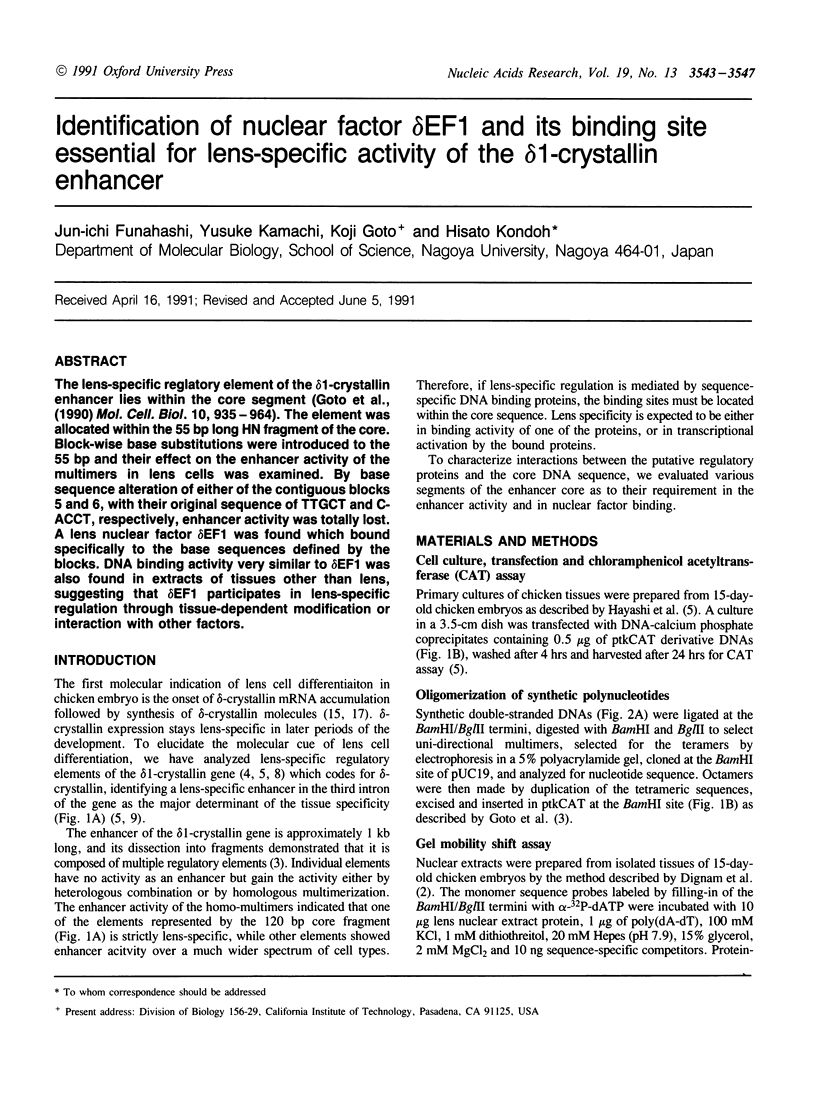Identification of nuclear factor delta EF1 and its binding site essential for lens-specific activity of the delta 1-crystallin enhancer (original) (raw)
Abstract
The lens-specific reglatory element of the delta 1-crystallin enhancer lies within the core segment (Goto et al., (1990) Mol. Cell. Biol. 10, 935-964). The element was allocated within the 55 bp long HN fragment of the core. Block-wise base substitutions were introduced to the 55 bp and their effect on the enhancer activity of the multimers in lens cells was examined. By base sequence alteration of either of the contiguous blocks 5 and 6, with their original sequence of TTGCT and CACCT, respectively, enhancer activity was totally lost. A lens nuclear factor delta EF1 was found which bound specifically to the base sequences defined by the blocks. DNA binding activity very similar to delta EF1 was also found in extracts of tissues other than lens, suggesting that delta EF1 participates in lens-specific regulation through tissue-dependent modification or interaction with other factors.

Images in this article
Selected References
These references are in PubMed. This may not be the complete list of references from this article.
- Baichwal V. R., Tjian R. Control of c-Jun activity by interaction of a cell-specific inhibitor with regulatory domain delta: differences between v- and c-Jun. Cell. 1990 Nov 16;63(4):815–825. doi: 10.1016/0092-8674(90)90147-7. [DOI] [PubMed] [Google Scholar]
- Dignam J. D., Lebovitz R. M., Roeder R. G. Accurate transcription initiation by RNA polymerase II in a soluble extract from isolated mammalian nuclei. Nucleic Acids Res. 1983 Mar 11;11(5):1475–1489. doi: 10.1093/nar/11.5.1475. [DOI] [PMC free article] [PubMed] [Google Scholar]
- Goto K., Okada T. S., Kondoh H. Functional cooperation of lens-specific and nonspecific elements in the delta 1-crystallin enhancer. Mol Cell Biol. 1990 Mar;10(3):958–964. doi: 10.1128/mcb.10.3.958. [DOI] [PMC free article] [PubMed] [Google Scholar]
- Hayashi S., Goto K., Okada T. S., Kondoh H. Lens-specific enhancer in the third intron regulates expression of the chicken delta 1-crystallin gene. Genes Dev. 1987 Oct;1(8):818–828. doi: 10.1101/gad.1.8.818. [DOI] [PubMed] [Google Scholar]
- Hayashi S., Kondoh H., Yasuda K., Soma G., Ikawa Y., Okada T. S. Tissue-specific regulation of a chicken delta-crystallin gene in mouse cells: involvement of the 5' end region. EMBO J. 1985 Sep;4(9):2201–2207. doi: 10.1002/j.1460-2075.1985.tb03915.x. [DOI] [PMC free article] [PubMed] [Google Scholar]
- Johnson D. G., Carayannopoulos L., Capra J. D., Tucker P. W., Hanke J. H. The ubiquitous octamer-binding protein(s) is sufficient for transcription of immunoglobulin genes. Mol Cell Biol. 1990 Mar;10(3):982–990. doi: 10.1128/mcb.10.3.982. [DOI] [PMC free article] [PubMed] [Google Scholar]
- Kondoh H., Yasuda K., Okada T. S. Tissue-specific expression of a cloned chick delta-crystallin gene in mouse cells. Nature. 1983 Feb 3;301(5899):440–442. doi: 10.1038/301440a0. [DOI] [PubMed] [Google Scholar]
- Liu Q. R., Tini M., Tsui L. C., Breitman M. L. Interaction of a lens cell transcription factor with the proximal domain of the mouse gamma F-crystallin promoter. Mol Cell Biol. 1991 Mar;11(3):1531–1537. doi: 10.1128/mcb.11.3.1531. [DOI] [PMC free article] [PubMed] [Google Scholar]
- Nakamura T., Donovan D. M., Hamada K., Sax C. M., Norman B., Flanagan J. R., Ozato K., Westphal H., Piatigorsky J. Regulation of the mouse alpha A-crystallin gene: isolation of a cDNA encoding a protein that binds to a cis sequence motif shared with the major histocompatibility complex class I gene and other genes. Mol Cell Biol. 1990 Jul;10(7):3700–3708. doi: 10.1128/mcb.10.7.3700. [DOI] [PMC free article] [PubMed] [Google Scholar]
- Nickerson J. M., Wawrousek E. F., Hawkins J. W., Wakil A. S., Wistow G. J., Thomas G., Norman B. L., Piatigorsky J. The complete sequence of the chicken delta 1 crystallin gene and its 5' flanking region. J Biol Chem. 1985 Aug 5;260(16):9100–9105. [PubMed] [Google Scholar]
- Ohno M., Sakamoto H., Yasuda K., Okada T. S., Shimura Y. Nucleotide sequence of a chicken delta-crystallin gene. Nucleic Acids Res. 1985 Mar 11;13(5):1593–1606. doi: 10.1093/nar/13.5.1593. [DOI] [PMC free article] [PubMed] [Google Scholar]
- Petryniak B., Staudt L. M., Postema C. E., McCormack W. T., Thompson C. B. Characterization of chicken octamer-binding proteins demonstrates that POU domain-containing homeobox transcription factors have been highly conserved during vertebrate evolution. Proc Natl Acad Sci U S A. 1990 Feb;87(3):1099–1103. doi: 10.1073/pnas.87.3.1099. [DOI] [PMC free article] [PubMed] [Google Scholar]
- Piatigorsky J. Lens differentiation in vertebrates. A review of cellular and molecular features. Differentiation. 1981;19(3):134–153. doi: 10.1111/j.1432-0436.1981.tb01141.x. [DOI] [PubMed] [Google Scholar]
- Pierani A., Heguy A., Fujii H., Roeder R. G. Activation of octamer-containing promoters by either octamer-binding transcription factor 1 (OTF-1) or OTF-2 and requirement of an additional B-cell-specific component for optimal transcription of immunoglobulin promoters. Mol Cell Biol. 1990 Dec;10(12):6204–6215. doi: 10.1128/mcb.10.12.6204. [DOI] [PMC free article] [PubMed] [Google Scholar]
- Shinohara T., Piatigorsky J. Quantitation of delta-crystallin messenger RNA during lens induction in chick embryos. Proc Natl Acad Sci U S A. 1976 Aug;73(8):2808–2812. doi: 10.1073/pnas.73.8.2808. [DOI] [PMC free article] [PubMed] [Google Scholar]
- Sorger P. K., Pelham H. R. Yeast heat shock factor is an essential DNA-binding protein that exhibits temperature-dependent phosphorylation. Cell. 1988 Sep 9;54(6):855–864. doi: 10.1016/s0092-8674(88)91219-6. [DOI] [PubMed] [Google Scholar]
- Tanaka M., Herr W. Differential transcriptional activation by Oct-1 and Oct-2: interdependent activation domains induce Oct-2 phosphorylation. Cell. 1990 Feb 9;60(3):375–386. doi: 10.1016/0092-8674(90)90589-7. [DOI] [PubMed] [Google Scholar]
- Wirth T., Staudt L., Baltimore D. An octamer oligonucleotide upstream of a TATA motif is sufficient for lymphoid-specific promoter activity. Nature. 1987 Sep 10;329(6135):174–178. doi: 10.1038/329174a0. [DOI] [PubMed] [Google Scholar]